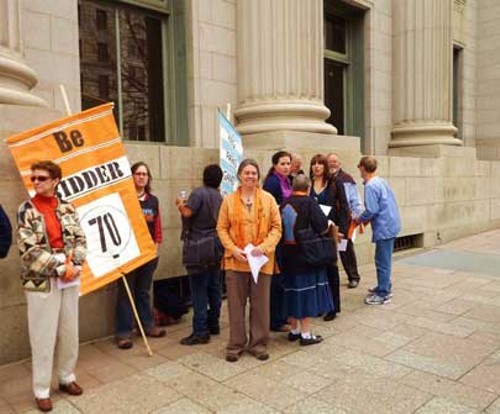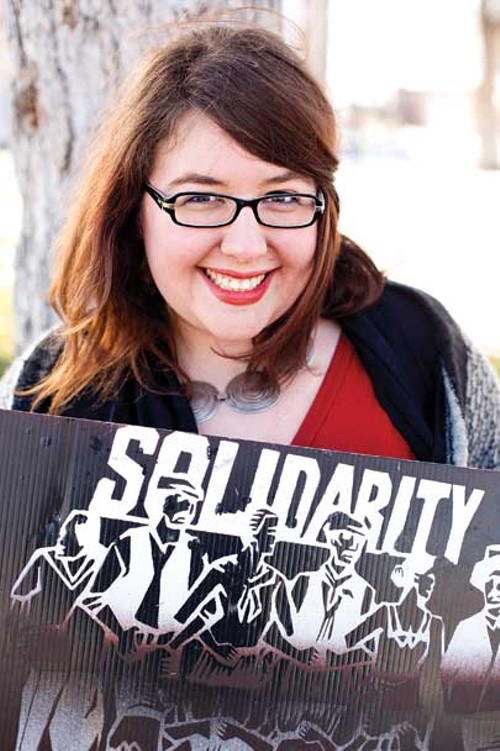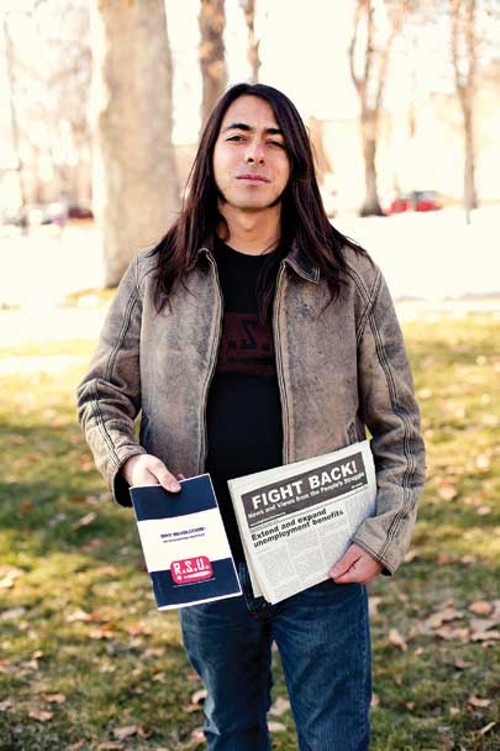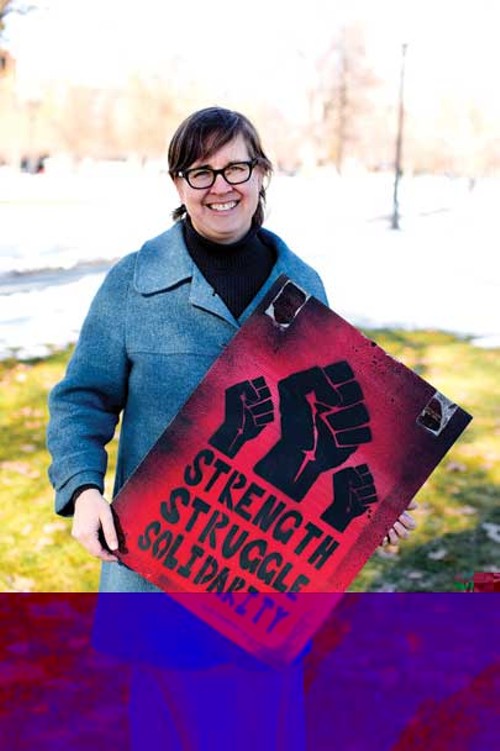Page 3 of 3
Still Fighting
the Good Fight
But it wasn’t all in vain, either. With their chants of “We are the 99 percent,” Occupiers raised public awareness of economic injustices and the fact that most of the world’s wealth is concentrated in the hands of a few.
Despite Occupy’s problems, Lucero says the movement “created a new discourse in this country. Now, there’s a discourse questioning why it is that the 1 percent get tax breaks and bailouts, and the rest of us get the shaft. That is not nothing; that is a huge, important advance in our society and in the struggle for working-class and oppressed people.”
Many insist the movement remains alive.
“I feel like Occupy isn’t dead at all,” Cordray says. “There are connections and relationships and knowledge that can never be erased that came directly from that experience at Pioneer Park.”
Jessica Lee agrees that the Occupy community is still strong and focused. “All of the friends and connections that we made are still around,” she says. “While we may not be camped in a tent in a park together, we’re still organizing together toward goals that are very similar to what we were doing in Occupy.”
Since leaving Occupy Salt Lake, Jesse Fruhwirth has been active in the Salt Lake City branch of the national Prison Divestment Campaign. Fruhwirth says many of its members met one another and formed alliances at Occupy Salt Lake.
The goal of the group is to raise awareness about and reform the current prison system, which allows private corporations to profit from the imprisonment of individuals. The Management & Training Corporation (MTC), the third-largest prison corporation in the world, is located in Centerville. In 2012, Jane Marquardt, MTC’s vice chair, ran for vice chair of the Utah Democratic Party. Prison Divestment Campaign activists interrupted a Democratic Party committee meeting where Marquardt was set to give her nomination speech. Marquardt lost the election.
“There was no forum to discuss what they were saying, so I’m sure some people didn’t vote for me,” Marquardt says. “But the end result was that a very good person won, Josie Valdez.”
Another movement that rose from the ashes of Occupy Salt Lake is the Utah Tar Sands Resistance. Lee has been an active member of the group since May 2012. She and her comrades believe that the proposed tar-sands mine in eastern Utah will have devastating effects on Utah’s environment, wildlife and public health.
“When you look at photos of the tar-sands pit in Canada, it’s like looking at Mordor,” she says. “My fear is that, 10 years from now, we’re going to look at the Western United States and it’s going to look just like that and we’re going to wonder, ‘Why did we let this happen?’ ”
The group has staged several “cough-ins” at the Utah Capitol during the 2013 legislative session to call attention to fossil fuels’ contribution to Utah’s horrendous air quality. The group also presented Utah Gov. Gary Herbert with a “Polluter of the Year” award, hijacking a stage at an energy conference to do so.
As plans for the mine move forward, however, the Utah Tar Sands Resistance is prepared to do more than simply educate and build awareness. Lee says the local group is in close contact with the Tar Sands Blockade, a Texas group that has garnered national attention for its monkey-wrench-style tactics of locking themselves to trucks and camping in trees to halt construction of the Keystone XL pipeline.
Lee believes that if push comes to shove, the Utah Tar Sands Resistance will consider more vocal forms of protest. “We are definitely ready to up our ante,” she says. “We are not going to let this happen.”
It’s clear that the faces of Occupy Salt Lake are still out there. It wasn’t a fad that went away when the economy improved. Those faces were outside the Salt Lake City & County Building in July 2012, “welcoming” the American Legislative Exchange Council (ALEC). They were camping near the proposed site of the first U.S. tar-sands strip mine in eastern Utah. And several former Occupiers were at January’s rally for Danielle Willard.
“A lot of the groups that I organize with are almost entirely made up of people who were involved in the Occupy experiment,” Fruhwirth says.
Seth Walker thinks the movement itself might even come back around. “I think America is going to eventually learn to embrace the Occupy movement. It is the movement in America right now that has the most heart for changing this world for everyone’s betterment.”
Henry agrees. Occupy “may be hibernating here in Salt Lake. Those ideas are still very real and present. Those problems haven’t gone away.”
| Generation Occupy
By Eric S. Peterson Many critics of the Occupy movement saw its activists as simple protesters who wanted the government to do something. They presumed Occupiers hoped that by living in tents and not showering, they would force the power establishment to eventually recognize and respond to their cause. Occupy never really had a clear set of demands. And critics missed the point of that entirely. Occupy wasn’t a million-man campout, or an en masse sit-in that refused to budge until the government took action. It was a community-building protest, seeking to actually replace the government with a leaderless, consensus-building process. The message of inequality was the battle cry because it defined Occupiers as people who were left out of the monied status quo. They believed the democratic system had been corrupted and was in need of a do-over. That’s why the camps allowed people to pitch in and practice rebuilding community together. Jesse Fruhwirth, a former City Weekly reporter and former Occupy Salt Lake member, says Occupy Salt Lake gave people an alternative way of living together, which would prove useful in case of a major political or economic collapse brought on by the inequalities of the system. “I feel like I was really practicing for a Mad Max future of America,” Fruhwirth says. Occupy may have dissolved, but its impact on a new generation of activists cannot be ignored. For example, Peaceful Uprising, an organization known for environmental activism, has picked up Occupy’s inclusive decision-making process. The group now does “community audits” that poll community members to see what areas of hope they should champion and an area of injustice they should fight against. Peaceful Uprising has used this model to help immigration reformers with the Salt Lake Dream Team and joined the Utah Tar Sands Resistance in protesting against a tar-sands strip mine’s approval in Utah. Kathy French, a professor of behavioral science at Utah Valley University, interviewed more than 150 Utah peace activists for an oral-history project and says groups like Occupy are similar to Quaker groups that protested during the Vietnam War and stressed consensus-building processes over any specific “list of demands.” “They will learn more from that than just latching onto one issue,” French says. |
| WHERE ARE THEY NOW? Deb Henry met her boyfriend through Occupy Salt Lake. She also ran for Salt Lake County Council in 2012 on a platform inspired by Occupy. Though she didn’t win, she was encouraged by how positively her message was received by the broader community. “I was just trying to find a new audience for distilling some of these ideas. It got a lot of traction, which was really exciting,” she says. She is currently in the process of switching careers, from structural engineering to teaching. “I want to be more intentional with how I’m spending my time and building community,” she says. “The youth of our community are the ones who really understand these things best.”
Raphael Cordray continues to run Free Speech Zone and feels that Occupy Salt Lake overwhelmingly changed the Salt Lake community for the better. “The activist community in Salt Lake has really been revitalized by relationships and trust that were built from the Occupy group,” she says.
Jessica Lee considers her time with Occupy “a great training ground for a lot of people who are now heavily involved in further campaigns and activism.” She has continued to use writing as a form of activism and helped organize a theater event with the ALEC Welcoming Committee. She currently works in the medical field and is in the process of writing creative nonfiction inspired by the Occupy Movement.
Gregory Lucero experienced disillusionment with Occupy Salt Lake but says that good came out of it. “The Occupy movement was broadly, widely and wisely successful in bringing a whole generation of people into activism,” he says. “It’s definitely launched a whole bunch of positive struggles against oppression.” Westminster College formed its own chapter of Lucero’s group, the Revolutionary Students Union, due to interactions at Occupy Salt Lake.
Rachel Carter remains heavily involved in Peaceful Uprising. She says she used her experience of getting arrested during the eviction as an opportunity to learn difficult but important truths about herself. “I ran into personal barriers that came from ‘mental colonization’—you’re not supposed to rock the boat, you’re supposed to go with the flow,” she says. “It was an interesting experience of running into how acculturated I was, even though I considered myself to be pretty well devoted to challenging the status quo when the status quo needed to be challenged.”
|
More by Lexie Levitt
-
Pioneer Craft House
Nonprofit fights to stay in South Salt Lake location
- Oct 16, 2013
-
Wild Women
Utah gals find a common love of the great outdoors
- May 24, 2013
-
Green Guide 2013: Bird Land
A crossroads for migratory birds, the Great Salt Lake and its wetlands are where birdwatchers’ dreams come true.
- Apr 17, 2013
- More »
Latest in Cover Story
Readers also liked…
-
Forget the family pedigree—Robert F. Kennedy Jr should not be the next president of the United States
Trojan Horse
- Jun 21, 2023
-
Women decry harassment and toxic culture at St. George auto dealership
Men at Work
- Oct 11, 2023










